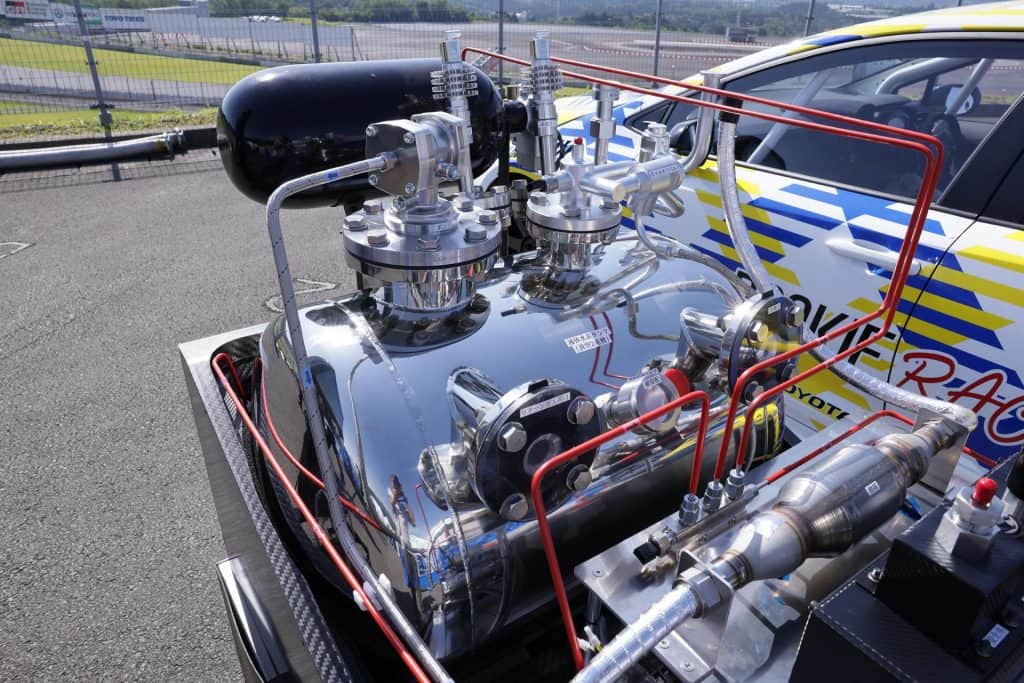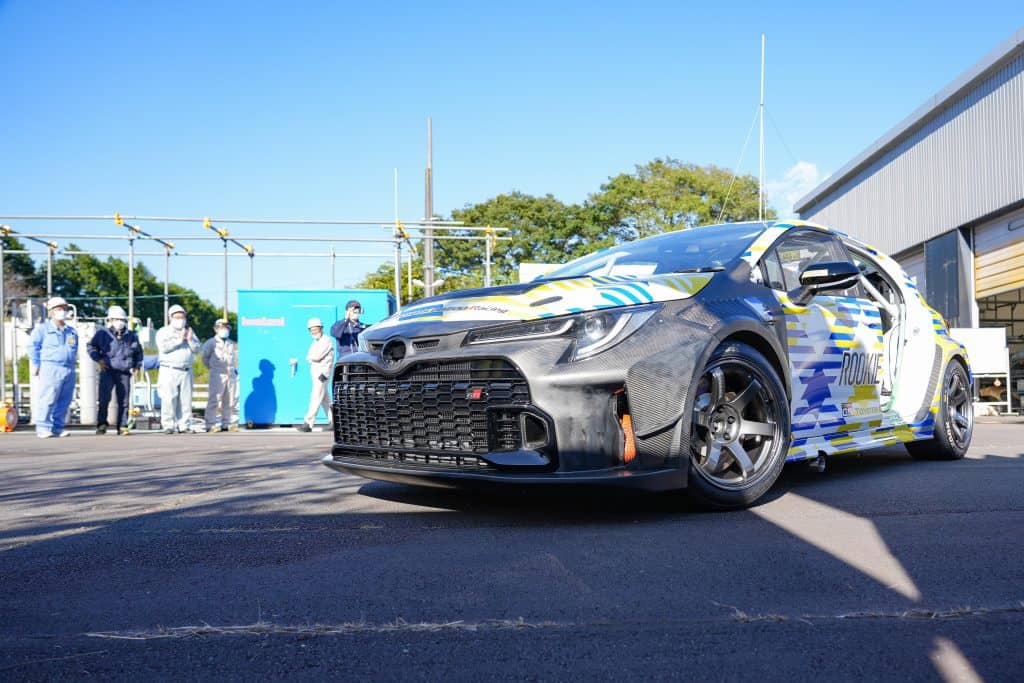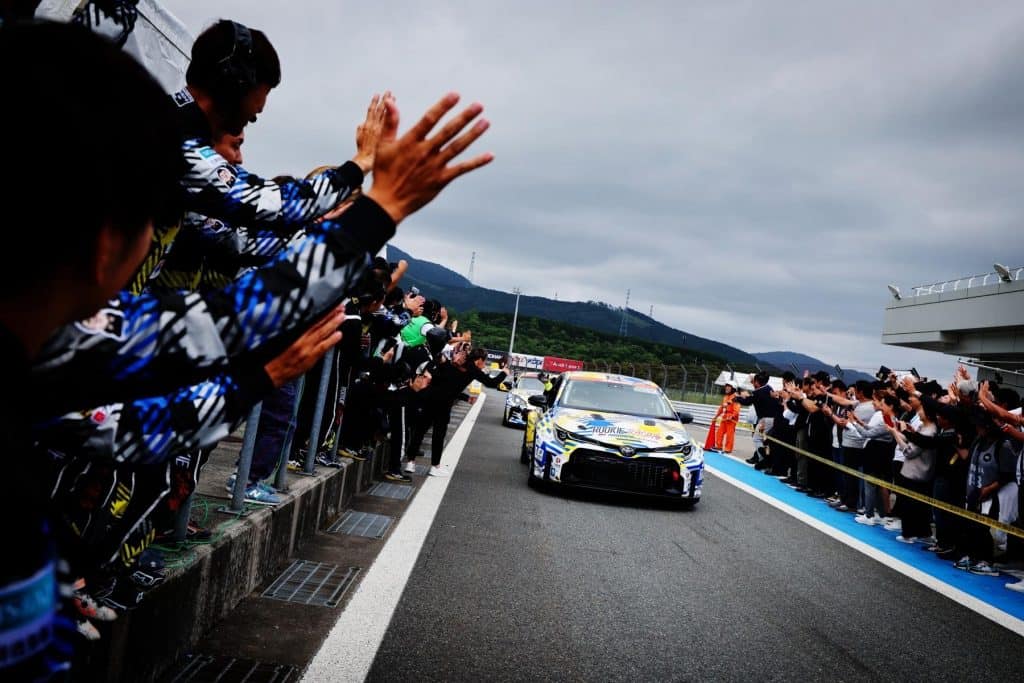A liquid hydrogen-powered GR Corolla finished the NAPAC FUJI SUPER TEC 24 Hours Race in Oyama, Shizuoka Prefecture. It was the second round of the 2023 ENEOS Super Taikyu Series and the liquid hydrogen-fueled car lapped the Fuji Speedway a total of 358 times or equal to 1,634 km. What’s surprising here was it only took them 18 months to develop. Of course, that was an arduous 18 months of work.
“We still haven’t been able to get it running.”
Those were the words of Tomoya Takahashi during the Super Taikyu Fuji 24 Hours in June 2022. He was the General Manager of GR Vehicle Development Division back then (but now he’s the GAZOO Racing Company President) and during that time, they already spent 6 months on the car to no avail.
They were really gunning for hydrogen power since they find it more dense, up to 1.7 times compared to gas hydrogen. This gives it a longer range per drop so to speak.
The first challenge for this part was keeping hydrogen liquid. Toyota had to make the tank insulated to keep the temperature inside at -253C, the point of liquification for hydrogen. Anything above that and they’ll lose their range. This also means that they’ll have to find someone that can supply this tank for a passenger car and not for commercial use which is more common.

Luckily, they found a partner in Shinko Industries – specifically their welders. Shinko’s expertise lie in engineering, construction, and other large scale projects so fitting a hydrogen tank for a passenger car is a daunting task for them. Even if they weld it by hand, the level of precision needed to finish the job is very high.
If that isn’t hard enough, the team was also racing against time. Toyota aims for their liquid-hydrogen powered Corolla to be ready within a year. This meant lots of processes for the car are running in parallel, with changes made on the fly and any alterations even to a single piece will result in the redesign of several components.
After a successful fitting of the hydrogen tank in the Corolla, it was off to the track. In November 2022, they finished a first run at Fuji Speedway. This got them excited for the season opener in Suzuka on March 2023 which will serve as the liquid-hydrogen powered GR Corolla’s debut.

It was stunted a few days from its debut. On March 8, the engine bay caught fire while doing a test run on the track. No one was hurt but there was damage to the vehicle forcing the team to pull out from the season opener. Despite this setback, the team continued with the development with Chairman Akio Toyoda backing them up.
“We undertook this effort to help create a hydrogen society. As we’ve said from the outset, the future will be shaped by acting with purpose and passion. Even while the engineers were saying it couldn’t be done, they’ve managed to develop the technology in an agile way while remaining competitive and keeping an eye on what’s going on around us. As a driver myself, I want people to see hydrogen not as a danger but as our future.” said Toyoda.
Instead of rebuilding the car, the team decided to move in parallel once again and applied improvements along the way. They made fixes to prevent the engine fire from happening again, as well as shave 50kg off the car’s weight. After all was said and done, Toyoda gave it his approval.
Still, there was one last hurdle before they can ease themselves for the 24-hour race. The pump that gets the liquid hydrogen from the tank can’t handle the -253C environment for a whole day straight. They planned for two pump changes – one in the morning and another at night – to replace the pump right before it’s in the range of failing. It’s a smart proposition but it will cost them time as their first trial took 4 hours for it to be finished.
Toyoda heard of this problem and motivated the team to do it in 3 hours. Project Manager Ito tried to bargain for 3.5 hours but was shutdown by Toyoda, happily saying ‘You don’t get to set your own limits!’ The team carried the Chairman’s words as their own and before the 3 hours was up, they were able to start the engine.

With no unplanned pitstops and enough practice on the pump replacement, the team was able to take the liquid hydrogen powered GR Corolla for 358 laps or 1,634 km around Fuji Speedway. It was also a full circle moment for the team as the first hydrogen powered Corolla also did the same number of laps in the same track back in 2021.
It might be a plain single race for some, but this is a big step forward for Toyota. If they can make ways for liquid hydrogen to power their performance cars, what more for the less demanding passenger cars? It also brings them one step closer to their goal of carbon neutrality so that we can move from one place to another with cleaner air for everybody.

